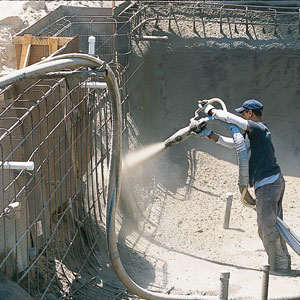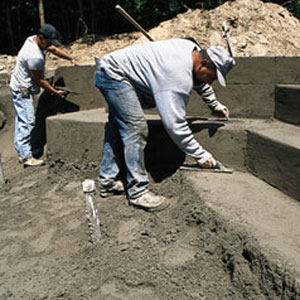Pool Design & Construction
Excavating
The digging is easy as long as it's dirt, but as it nears the bottom, the
excavator strikes ledge, aka solid rock. So into the hole goes a hydraulic
rock splitter for a day of chipping and breaking. When all is done, some
150 cubic yards of dirt and rock are taken out, half of which is used for
backfilling and grading. The rest is hauled away.
Plumbing and Reinforcement
After laying in 6 to 8 inches of sharp-edged "trap rock" for a stable base, PVC plumbing for the drain
and cleaning system, and a layer of gravel, the crew from the pool's skeleton with 3/8-inch and 1/2-
inch rebar. The criss-crossing rods are wired together, and the whole assembly is then electrically
grounded to slow corrosion and to protect against accidental shock from pool equipment
Forming the Concrete Shell
A barely moistened mix of cement and sand — called gunite for the way it's sprayed
in place — shoots from a pneumatic nozzle to create a pool bottom and sides that are
up to a foot thick. It takes a day and about 45 cubic yards of gunite to make this shell,
plus a full week of twice-a-day watering to keep the concrete wet while it cures and
hardens.
Smoothing and Step-Building
The concrete goes on rough, so before it hardens the workers take their floats to it, not only
to smooth the surface but also to make steps, benches, and other underwater features. None
require any rebar or reinforcing mesh; they're formed from solid concrete and lots of elbow
grease. After the concrete has been worked, the ground around the shell is backfilled and
graded and compacted to prepare for the pool deck.
Filling
The finish plaster hardens and cures in the presence of water, so as soon as the pool is done it's filled
immediately with water that has been brought in via water trucks.




